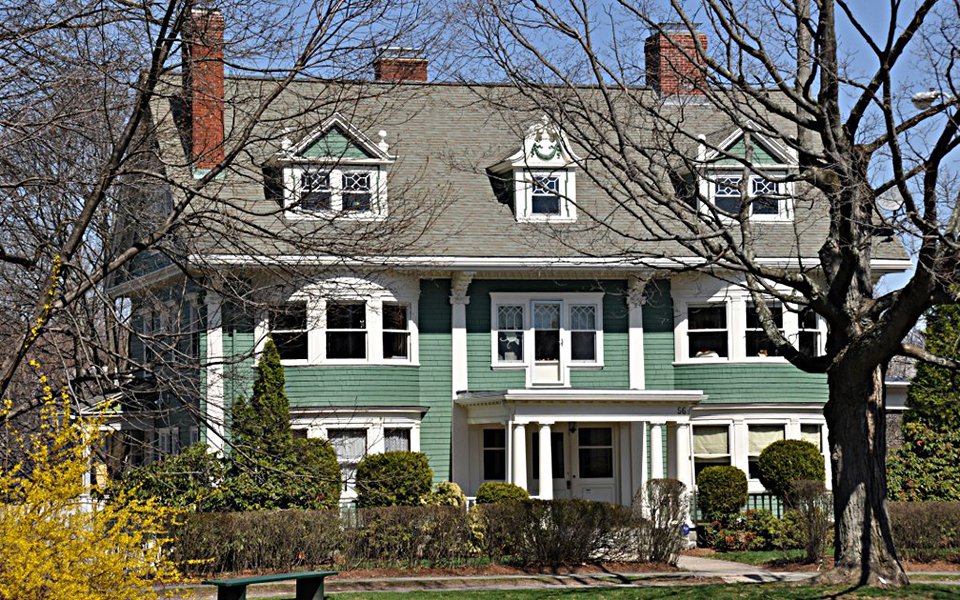
Photo: John H. McGill House, circa 1902, located at 56 Vernon Street, listed on the National Registe in 1980; photographer unknown; accessed June, 2021, en.wikipedia.org/wiki/John_H._McGill_House.
Medford City Hall is located at 85 George P. Hassett Drive, Medford MA 02155.
Phone: 781‑396‑5500.

Photo: John H. McGill House, circa 1902, located at 56 Vernon Street, listed on the National Registe in 1980; photographer unknown; accessed June, 2021, en.wikipedia.org/wiki/John_H._McGill_House.
Neighborhoods
Medford [1] is fortunate having a substantial heritage of old buildings from its long past. On this architectural and historical inheritance depends, in major measure, Medford's identity as a city set apart from other cities.
A handful of Medford' s historical structures are outstanding, renowned, relatively large structures which attract the public eye; these constitute hardly 5% of Medford's heritage. The other 95% consists of medium-sized or small private houses including an estimated nearly eighty from the Greek Revival era and many others from the Victorian era: the homes of ordinary, sometimes humble citizens.
Many of- these are not striking in themselves. Taken together in streets and neighborhoods, however, they constitute Medford's chief source of uniqueness and pride. In no other respect but in her historically registered buildings does Medford rank within the top 1% of American communities.
The City of Medford is an historic suburban city located on the Mystic River with several small streams that provided waterpower for early industries. Originally the site of estates owned by Governors Craddock&Winthrop, Medford became a town in 1695 and a city in 1892.
Located in Eastern Massachusetts, bordered by Everett and Malden on the east, Stoneham on the north, Somerville on the south, Arlington on the west, and Winchester on the northwest. Medford is 5 miles northwest of Boston, 9 miles southwest of Lynn, 20 miles south of Lowell, and 223 miles from New York City. [www.bostoncentral.com, accessed June, 2021]
Beginnings [1]
Medford was incorporated as a town in 1684 and as a city in 1892.
In the early days of its settlement, rich loam near the river banks beckoned farmers, and the surging tides of the Mystic River offered thriving fisheries. Shipbuilding was soon underway. John Winthrop, a year before settling on Ten Hills Farm at Somerville, had launched the 'Blessing of the Bay' at Medford. Then followed a century of depression, until the New England rum and slave trade sprang up.
Medford rum had its start when the Hall family set up a wooden still on the site of a spring, to which the special flavor of the rum was attributed. The Hall formula, used for 200 years, was finally destroyed by General Samuel C. Lawrence, when Medford distilling came to an end.
The navigable Mystic River was the direct cause of the other very substantial economic activity of Medford. Freighting produce to the State capital by boat became a bustling enterprise.
Medford developed into a supply shop for New Hampshire and Vermont, furnishing iron, steel, lead, salt, molasses, sugar, tea, codfish, chocolate, gunpowder and rum at prices lower than Boston. In addition Medford merchants engaged directly in extensive trade with foreign and domestic ports. Barrell-making and slaughtering thrived.
One day in the year 1802, Thatcher Magoun, a youth on holiday from a Charlestown shipyard, was rambling about Winter Hill. In a vision he saw a thriving shipyard on the river banks below him, himself its master. Excited he clattered down the hill and boarded a two-masted schooner lying alongside a distilling-house wharf. Breathlessly he plied the amazed captain with all sorts of questions. A year later he returned and laid the keel of his first ship.
Thatcher Magoun's project came at a critical moment. The English navigation laws, after the Revolution, ended American trade with the British West Indies, and New England merchants were frantically seeking new markets.
Finally Yankee ingenuity found a way out, in a new trade with China. Because their two hundred to three hundred ton capacity made possible the navigation of the shallow bays of the northwest coast, many Medford vessels were dispatched to the Pacific. "Medford-built" found its way into the idiom of the sea.
Such Medford builders as J.O. Curtis, Hayden and Cudworth, and S. Lapham had more fast California passages to their credit, in proportion to the number of clipper ships built, than those of any other town.
Sailing vessels became definitely unprofitable with the Civil War and the introduction of steamships. In 1873 the last Medford-built ship was launched. Nor did the distilleries long survive; by 1905 they, too, had ceased.
Nearby Towns: Arlington Town • Boston City • Brookline Town • Burlington Town • Cambridge City • Chelsea City • Everett City • Malden City • Melrose City • Revere City • Saugus Town • Stoneham Town • Wakefield Town • Winchester Town •